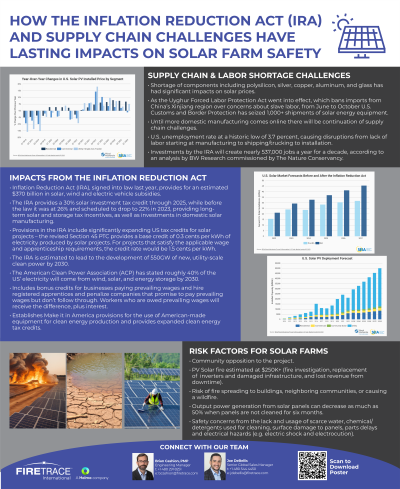Back

Finance and Asset Management
How the Inflation Reduction Act (IRA) and Supply Chain Challenges Have Lasting Impacts on Solar Farm Safety
Tuesday, September 12, 2023
4:30 PM - 5:30 PM PDT
Location: Poster Area, Booth #11024, Level 1, Venetian Expo Hall


Brian Cashion, PMP, PMP
Engineering Manager
Firetrace nternational
Scottsdale, Arizona, United States
Poster Presenter(s)
Since the start of the pandemic, the global supply chain has been disrupted without an end in sight. A shortage of labor, lockdown restrictions, bottlenecks in the supply chain, and increased demand for certain commodities have led to soaring raw material prices due to a litany of reasons.
As the level of solar, wind, and energy storage projects are expected to dramatically increase, it is vital to gain a thorough understanding of the regulations and safety risks and how it affects the renewables sector. One particular risk a solar farm can face is fire. With no formal reporting mechanism on fire incidents for renewable energy, fire risk is not only underreported but also underestimated. In addition, a fire can have a significant impact on reputation, downtime, and replacement costs. As more solar farms come online, actions can be taken to understand and mitigate fire risk for both new and existing solar farms.
However, fire risk is not the only challenge faced by solar farms. Prior to construction of the solar farm, an owner/operator could encounter community opposition to the project. Post construction, a study found that the output power generation from solar panels decreased as much as 50% when not cleaned for 6 months. This poses a number of safety concerns including the usage of scare water and the chemical/detergents used, surface damage, electrical hazards, and a shortage of a trained workforce. Delays in acquiring need parts caused by supply chain can also pose a risk. Lastly, with any form of the generation of electricity there is a risk factor of electric shock and electrocution. Understanding overall risks that a solar farm needs to take into consideration is vital to the success and growth of the renewables industry.
As the level of solar, wind, and energy storage projects are expected to dramatically increase, it is vital to gain a thorough understanding of the regulations and safety risks and how it affects the renewables sector. One particular risk a solar farm can face is fire. With no formal reporting mechanism on fire incidents for renewable energy, fire risk is not only underreported but also underestimated. In addition, a fire can have a significant impact on reputation, downtime, and replacement costs. As more solar farms come online, actions can be taken to understand and mitigate fire risk for both new and existing solar farms.
However, fire risk is not the only challenge faced by solar farms. Prior to construction of the solar farm, an owner/operator could encounter community opposition to the project. Post construction, a study found that the output power generation from solar panels decreased as much as 50% when not cleaned for 6 months. This poses a number of safety concerns including the usage of scare water and the chemical/detergents used, surface damage, electrical hazards, and a shortage of a trained workforce. Delays in acquiring need parts caused by supply chain can also pose a risk. Lastly, with any form of the generation of electricity there is a risk factor of electric shock and electrocution. Understanding overall risks that a solar farm needs to take into consideration is vital to the success and growth of the renewables industry.
